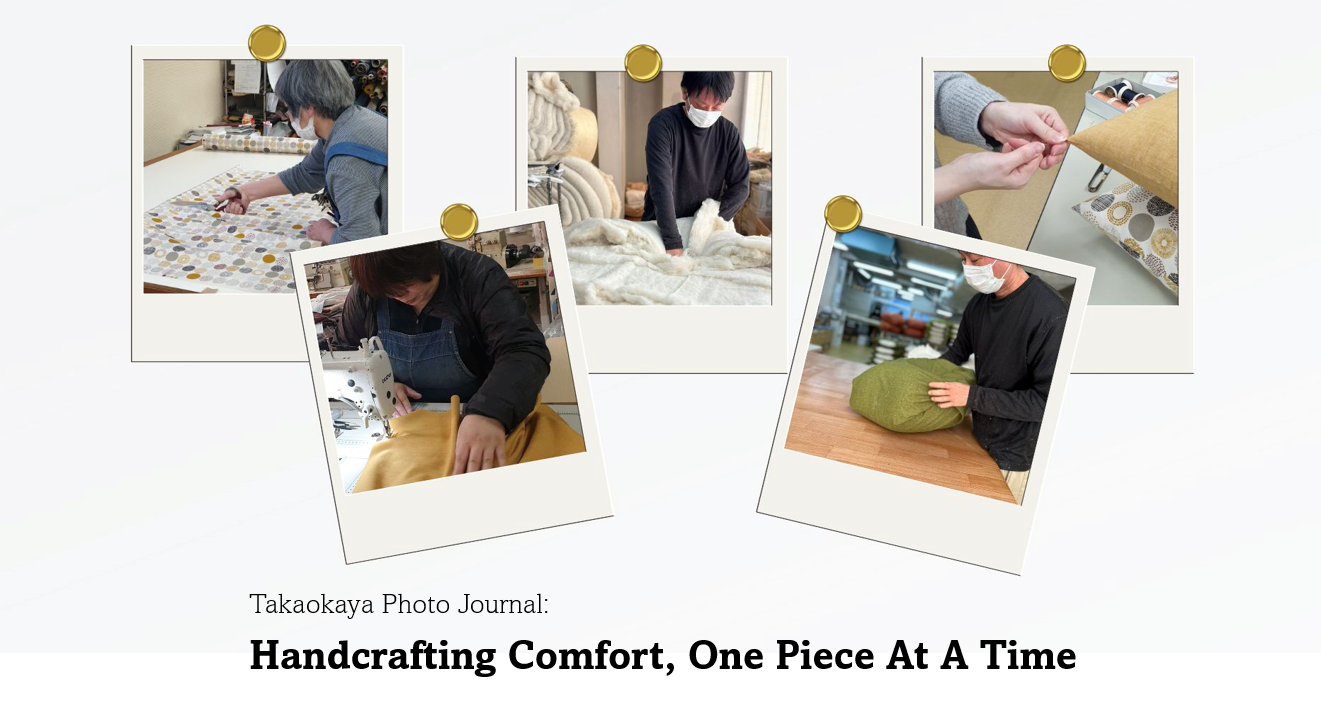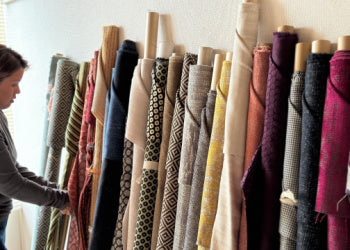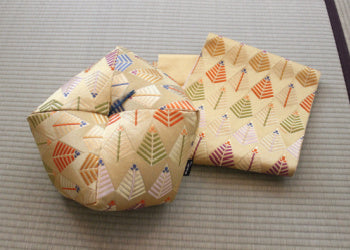
Recently, we received a special request from a customer to document the manufacturing journey of our made-to-order Kyoto Zabuton cushions. She wanted to be able to experience the handcrafting process of the zabutons, as she has a deep appreciation for all things handcrafted and Japanese craftsmanship.
She was extremely delighted to receive the photo journal, alongside with the Zabuton cushions she ordered. Knowing the manufacturing journey of the Zabuton cushions has made her Zabuton cushions extra special and meaningful.
Come along on this manufacturing journey of our Kyoto Zabuton cushion with us, and learn how we handcraft our Kangu to bring you the immense comfort for your relaxation.
Where it all begins: Cutting

The birth of every beautiful Kangu (tools of relaxation) begins with our senior craftswoman, Imura-san, who is like the chief architect of the craftsmen in the entire Takaokaya workshop. Her main role is to cut the fabrics into the shapes and sizes required to make the different Kangu.
As simple as it might sound, the cutting craftsmen need to possess the precision of an engineer, keen eye of an artist and the steady hands of a surgeon. If the fabrics are not properly measured and cut, it will affect the rest of the making process and how the Kangu turns out. Working with over 100 different types of fabrics, Imura-san also needs to consider the flow and direction of the patterns and textures on the fabrics, the shape of the Kangu that is being made as well as how to not waste fabric, before she snips away.
Once the cutting is done, she will pass the fabrics over to the sewing section.
Shaping the Kangu: Sewing

At the sewing section, this is where the Kangu starts taking shape. With the help of a sewing machine, the craftswomen will sew the fabrics together to form the shapes of the Kangu they are making.
This is Wakabayashi-san, one of the sewing craftswomen in the workshop. She is like a professional racecar driver, only she maneuvers the sewing machine speedily along the fabrics to shape the Kangu instead of a car along the racetrack. With more than 20 years of sewing experience, she can meticulously sew the fabrics in place without any line or marking or pins.
After the sewing is done, she will iron the fabrics to further set the shape of the Kangu, as well as smooths out any creases on the fabrics. The shaped fabric casings will then be passed on to the stuffing section.
Crafting the Soul of the Zabuton: Stuffing

Stuffing is one of the most important crafting processes when making the Kyoto Zabuton as it determines the comfort of the cushion, which is the soul of the zabuton. It takes many years of practice for the craftsmen to be able to create the perfect zabuton which is ultra plush in the center while the rest of the cotton batting evenly distributed.
This is Taniyama-san, who has been honing his craft of stuffing for more than a decade. The challenge here is to tear the cotton batting into smaller square sheets and arrange them in different layers to be stuffed into the fabric casing. Unlike Imura-san, he cannot use any measuring tool. Instead, he relies on his many years of experience when he tears the cotton and stack them up in layers.

The bottom layers of the cotton batting are larger than the top layers and after the layers of cotton batting are properly arranged, it is time to stuff them into the fabric casing.
Taniyama-san has to hold the gathered layers of cotton batting firmly in his hands when he stuffed so that the arranged layers stay intact. The layers are arranged in a specific manner to ensure that the center of the cushion stays the plumpest for a comfortable sitting experience.

After filling the fabric casing, Taniyama-san still has to arrange the cotton batting to make sure that the layers stay in place and that the cotton is evenly distributed around the cushion.
He will brush off the straying bits of cotton on the cushion and put them back into the case. Once he is satisfied with the fluffiness and plushness of the cushion, then he will pass it on to the finishing section.
And a Zabuton is born: Finishing

After the zabuton is sealed closed, it is time to put on the finishing touches. First, the "Sampo-Toji" stitch which goes in the center of the cushion, to keep the cotton stuffing in place, as well as to give an indication of the direction of zabuton. Unlike ordinary zabutons which use cross shaped center stitch, the Sampo-Toji is a y-shaped stitch. The tail of the “Y” indicates that it is the front of the zabuton.
Murakami-san, one of the finishing craftswomen, was trained to sew Kimono. Before she can stitch the Sampo Toji on, she had to find the center of the cushion, by ensuring the thread measures the same length from all directions diagonally. Once she finds the center, she has a measuring tool to help her mark out where the “Y” will be on the cushion.

After the markings are done, Murakami-san will proceed to do the Sampo Toji stitch, turning the cushion back and forth, to insert the needle at the marked positions. After securing the threads at all the desired spots on the cushion, she will then tie a knot to hold all the threads together. The front of the cushion also has a dome shaped arch in the center while the back of the cushion is flatter. This shape not only provides extra fluffiness but also prevents the zabuton cushion from thinning too quickly, with frequent use. It takes a very skilled craftsman to achieve a plump and natural curve shape of the zabuton cushion.
To make sure that the length of the tassels for both the front and back are equal, she used the cutter as a gauge to trim off the excess length of the tassels.

The last step before the zabuton is completed is to sew the corner tassels known as “Sumi-Fusa”. It does not only function as a decoration, but it is also a technique used traditionally to ensure that the cotton filling does not come out from the corners of the cushion. In ancient Japan, it is believed that putting tassels on the corners of the cushions prevents evil from possessing the user.
After the tassels are completed, the Kyoto Zabuton is finally ready to provide Kutsurogi (relaxation) to its proud owner.
Want a piece of handcrafted Japanese comfort for the ultimate relaxation experience? Click here to order your made-to-order Kyoto Zabuton or get in touch with us if you would like to create a unique, customized piece of Kangu via email.



Comments
Kyoto Zabuton cushions. It’s a true privilege to witness the meticulous craftsmanship and dedication that goes into each one.
Two aspects of your post resonated deeply with me:
Celebrating the Hands of the Maker: Your detailed descriptions of the artisans, from Imura-san’s precise fabric cutting to Taniyama-san’s intuitive cotton stuffing technique, bring the human element of craftsmanship to life. It’s a beautiful reminder that each zabuton is not just a product, but a vessel imbued with the skill and care of the individual who made it.
The Art of Mindful Manufacturing: The focus on sustainability, from minimizing fabric waste to using natural cotton batting, reflects a deep respect for the environment and a commitment to mindful practices. This philosophy aligns perfectly with the values of yoga, where we strive to live in harmony with ourselves and the world around us.
Your post is a testament to the enduring power of handcrafted traditions and the artistry that goes into creating something truly special. It has left me with a renewed appreciation for the beauty and intentionality behind the zabuton cushions I use in my yoga practice.
With gratitude,
Evelina Hawthorn
https://medium.com/@evelina_70951/